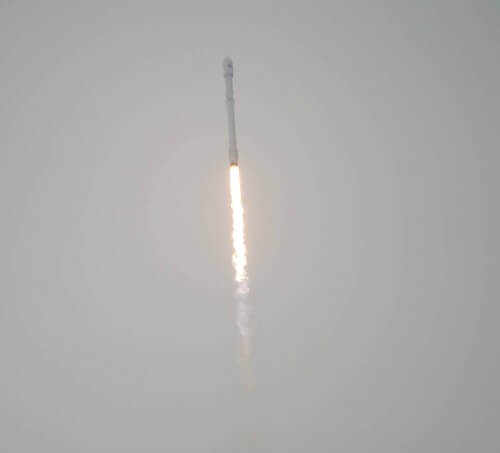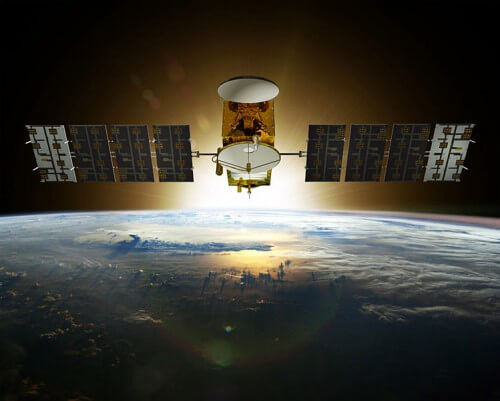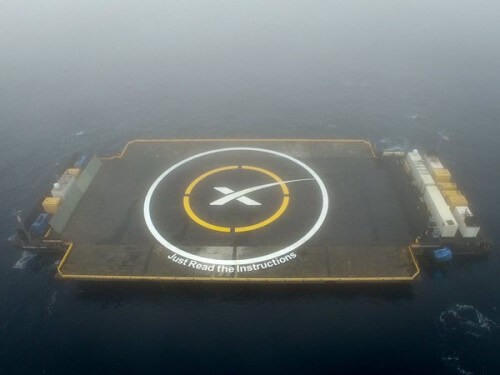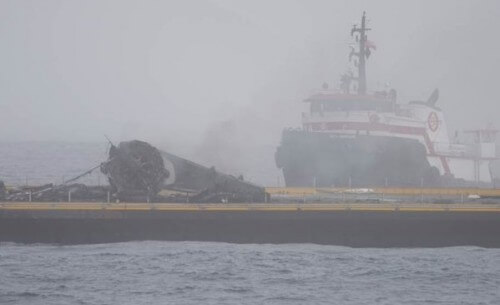This time the rocket stage aimed at a mobile rig in the middle of the Pacific Ocean, but the attempt failed due to a malfunction in opening one of the landing legs of the rocket stage. Despite this, the main objective of the mission, the launch of the Jason-3 satellite into orbit, was successfully completed.

The Falcon 9 launch took place under a heavy fog cover. Source: NASA
Only a month later The historic achievement of the SpaceX company - in which it managed to re-land the first stage of the Falcon 9 launcher on a ground pad - the company almost managed to reproduce the same success. This time the rocket stage aimed at a mobile rig in the middle of the Pacific Ocean, but the attempt failed due to a malfunction in opening one of the landing legs of the rocket stage. Despite this, the main objective of the mission, the launch of the Jason-3 satellite into orbit, was successfully completed.
The satellite that was launched as part of the experiment was designed to map the level of the ocean, in order to study the effects of global warming and predict weather phenomena such as tropical storms or the El Nino phenomenon that the world is experiencing these days. The project is an international collaboration of the US National Oceanic and Atmospheric Administration (NOAA) and NASA with the French Space Agency and the European Organization for the Exploitation of Meteorological Satellites (EUMETSAT).

As in all previous attempts, the company took advantage of the commercial launch of the satellite to continue its attempts to develop a multipurpose launcher. Such a launcher would be able to significantly reduce the cost of launching into space, since instead of rebuilding an entire rocket for each launch, it would be possible to simply refuel and prepare for another launch. Right now the company is only focusing on the soft launch of the first stage of the two-stage launcher.
About a month ago, the company succeeded in returning the first stage - but then it landed on a ground lander at the Cape Canaveral space base in Florida, and this time the company tried to land it on a mobile (and unmanned) rig in the waters of the Pacific Ocean, which measures only 90 by 50 meters.
According to my words SpaceX founder and CEO Elon Musk, the current failure happened due to a malfunction in the locking of one of the launcher's landing legs. Although the launcher was precisely aimed at the marine launch pad and landed at the desired speed, but due to the malfunction, it tilted on its side and fell after landing.

It is interesting to note that the reason that SpaceX did not perform the landing test on a ground pad but on a rig in the middle of the ocean, is that it did not receive the necessary approvals for this. This is because the launch did not take place from the Cape Canaveral Spaceport in Florida like last time, but from the Vandenberg Base in California, where it does not have a dedicated ground pad like the one it built in Cape Canaveral.
One of the reasons SpaceX is trying to land launchers in the middle of the ocean is that this capability will give it more flexibility in determining the nature of the launch according to the changing needs of each mission. For example, landing the first stage on a land base requires more fuel - since the launcher moves very far from the launch base and the missile has to perform rocket combustion just to return to the base, not just to slow down its speed. Therefore, returning the first stage to a land base is more suitable for the launch of a relatively light payload or a low orbit around the Earth, which require less fuel.

This is the company's third failure in trying to land the rocket stage on a pad in the ocean. This is what it looked like the last time in April 2015: this time the rocket stage aimed at a mobile rig in the middle of the Pacific Ocean, but the attempt failed due to a malfunction in opening one of the landing legs of the rocket stage. Despite this, the main objective of the mission, the launch of the Jason-3 satellite into orbit, was successfully completed.

3 תגובות
To Elisef Kosman I did not receive an answer to my question please
A question for Elisef Kussman, how long are Shana's crew currently in space, and more importantly, why are they on the station for a long time, what is the research for, thank you Avi
sad